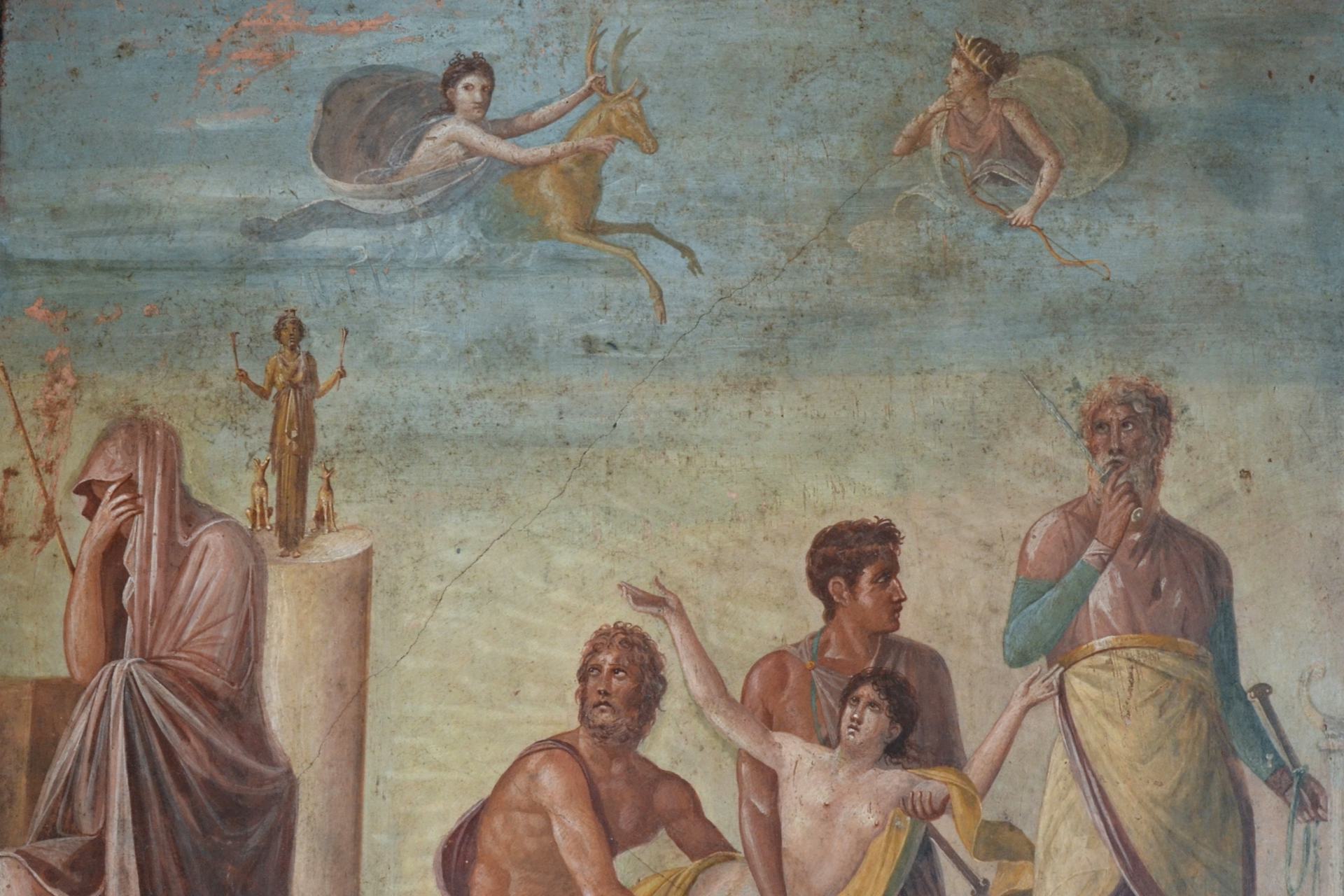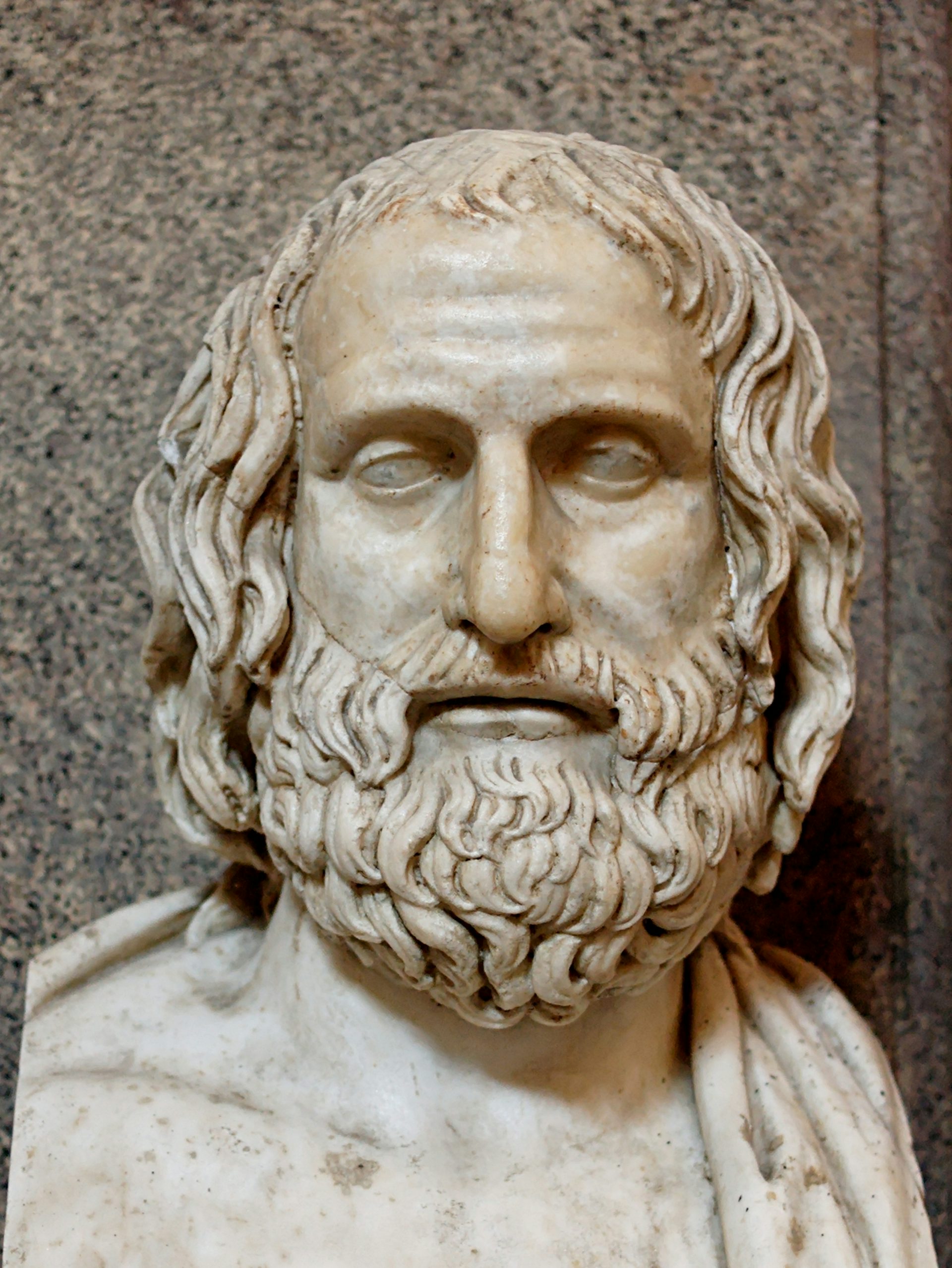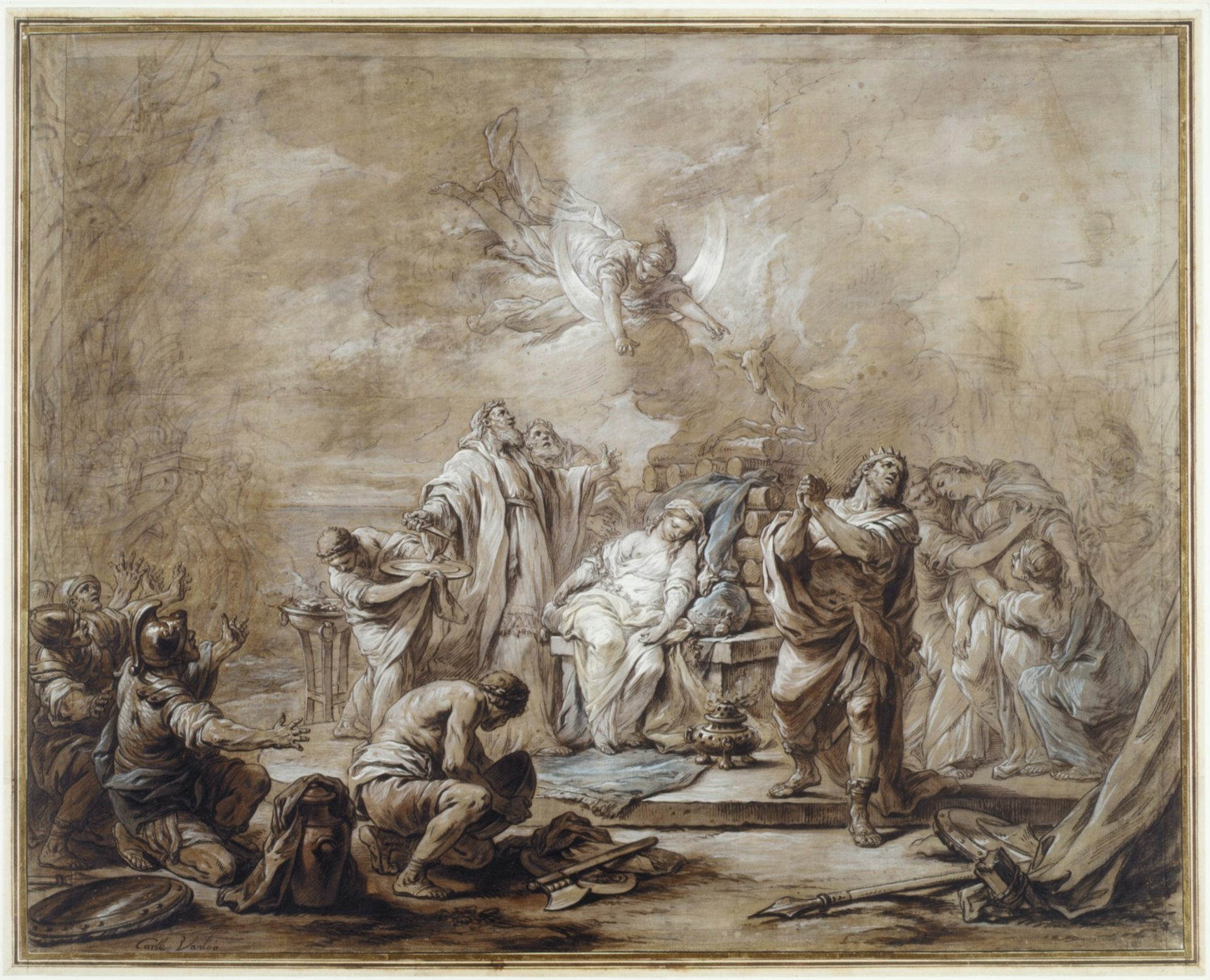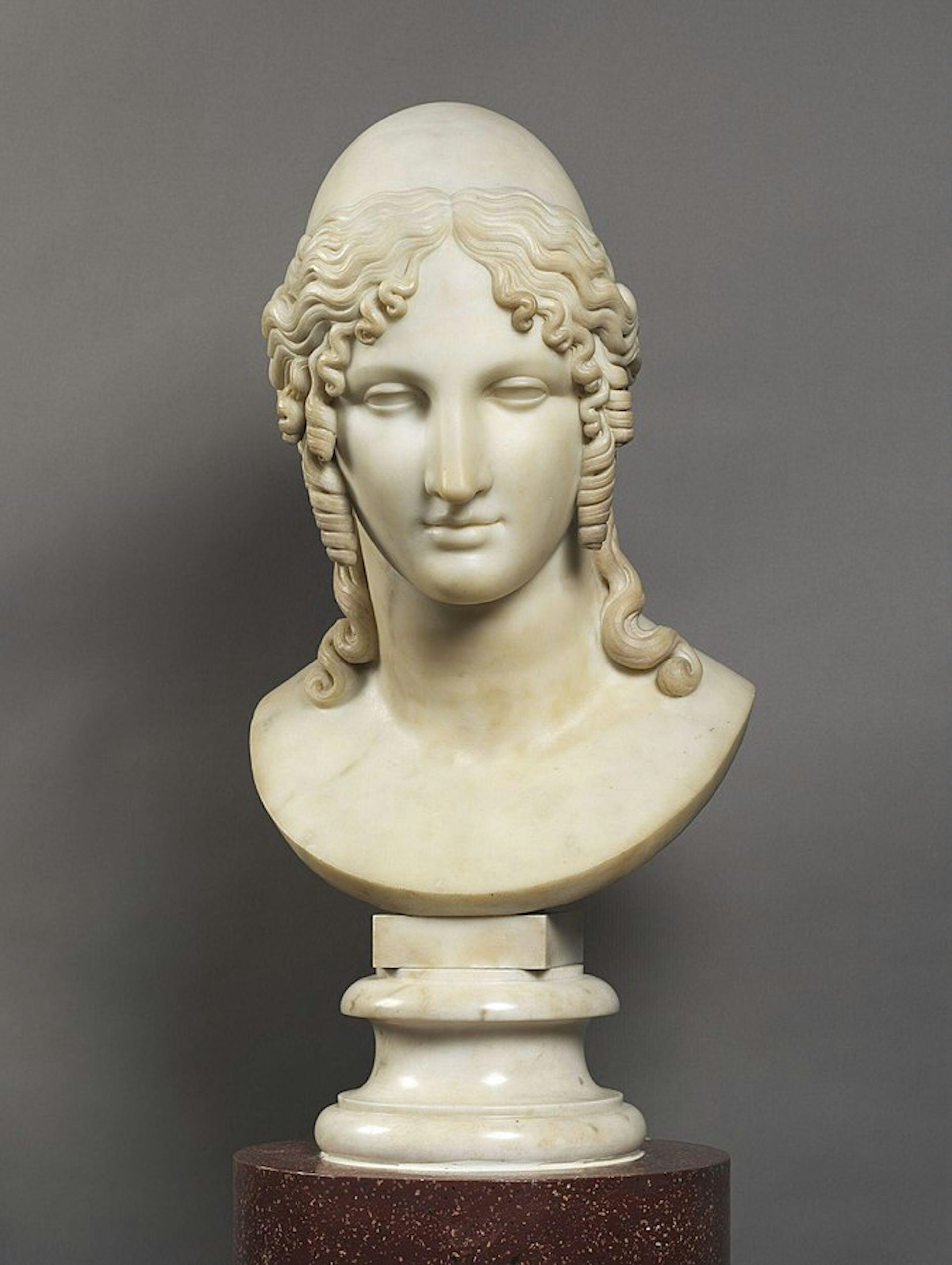Iphigenia in Aulis

Fourth-style fresco from the House of the Tragic Poet in Pompeii showing the sacrifice of Iphigenia (ca. 60–79 CE)
National Archaeological Museum, Naples / Carole RaddatoCC BY-SA 2.0Title
Pronunciation
English
Greek
Iphigenia in Aulis Ἰφιγένεια ἐν Αὐλίδι (Īphigéneia en Aulídi) Phonetic
IPA
[if-i-juh-NAHY-uh], [AW-lis] /ˌɪf ɪ dʒəˈnaɪ ə/, /ˈɔ lɪs/
Author
Euripides, author of the Iphigenia in Aulis, was an Athenian tragedian who is usually said to have lived from around 480 BCE to 406 BCE. He was the youngest of the three canonical Athenian tragedians (the other two being Aeschylus and Sophocles) and was known for exploring avant-garde, subversive, and innovative themes.

Roman bust of Euripides after a Greek original from ca. 330 BCE
Vatican Museums, Vatican / Marie-Lan NguyenPublic DomainOver the course of his career, Euripides composed some ninety plays, eighteen of which survive in full.[1] Despite his formidable output—we have more plays by Euripides than by Aeschylus and Sophocles combined—he won only four victories at the annual Dionysia competition during his lifetime (with a fifth awarded the year after his death). Yet Euripides’ popularity and literary influence have continued to grow, and some scholars now regard him as the greatest of the Athenian tragedians.
Little is known about Euripides’ personal life; most ancient testimonia and biographies read more like fable than fact. Euripides seems to have been born on Salamis, an island near Athens, to a family of hereditary priests. He was married twice, both times unhappily, and had three sons.
Ancient sources claimed that Euripides was a recluse and may have even lived alone in a cave in Salamis, though the veracity of such stories is obviously dubious. He died in 406 BCE at the court of the Macedonian king Archelaus.
Throughout his lifetime—and after his death, too—Euripides had a reputation as a challenging and controversial playwright. The comedian Aristophanes, one of his contemporaries, often mocked Euripides as an impious snob. In time, however, Euripides came to be recognized for his capable exploration of emotional realism, his innovative treatment of traditional mythology, and his persistent questioning of contemporary values.
Mythological Context
Euripides’ Iphigenia in Aulis dramatizes the myth of the sacrifice of Iphigenia, daughter of the Mycenaean king Agamemnon. The goddess Artemis demanded the girl’s life in exchange for a wind to blow the Greek fleet to Troy.
Iphigenia’s story is part of the larger myth of the Trojan War, which broke out when the Trojan prince Paris carried off Helen, a Greek queen from Sparta. The Greeks assembled a vast army to sail to Troy and bring her back.
The myth of Iphigenia’s sacrifice was adapted many times throughout antiquity. Though there are no explicit references to the sacrifice in either of the Homeric epics (the Iliad and the Odyssey),[2] we know that the myth was retold in the (now lost) epic known as the Cypria, which described the events leading up to the Trojan War.
Many other authors who preceded Euripides, including Hesiod, Stesichorus, Aeschylus, and Sophocles, also treated this myth in their works. Euripides himself dealt with the story in one of his earlier tragedies, Iphigenia among the Taurians.
Naturally, these diverse sources represented the myth of Iphigenia in quite different—sometimes even radically different—ways. One of the main divergences between the various traditions involves the story’s ending.
In some accounts—including the one in the background of Aeschylus’ Oresteia—Iphigenia is sacrificed as planned. But in other accounts—including the Cypria, Euripides’ Iphigenia among the Taurians, and possibly Hesiod’s Catalogue of Women—Artemis takes pity on Iphigenia and rescues her at the last moment, substituting a deer in her place (much as God in the Old Testament substitutes a ram for Isaac when Abraham is about to sacrifice him).
Other details also differ across the various retellings of the myth. For example, the daughter sacrificed by Agamemnon at Aulis is sometimes referred to by other names, including Iphimede,[3] Iphigone,[4] or Iphianassa.[5] Some accounts, including Euripides’ Iphigenia in Aulis, have Agamemnon lure his daughter to Aulis with the promise that she will be wed to Achilles, while others omit this detail.
Moreover, while in Euripides’ Iphigenia in Aulis the girl is accompanied by her mother Clytemnestra—a source of much of the play’s tension and pathos—most other versions seem to have had Iphigenia come to Aulis alone.
Euripides’ Iphigenia in Aulis is also a metaliterary work, highly conscious of its place within a mythical and literary tradition stretching back centuries. All of the play’s main characters—including Agamemnon, Iphigenia, Menelaus, and Achilles—would have been known from numerous earlier sources, most notably Homer’s Iliad and Odyssey.
Indeed, Euripides responds to and reworks the Homeric epics in intriguing ways. The conflict between Agamemnon and Achilles, for instance, is what drives the action of the Iliad, and Euripides foreshadows this conflict in his Iphigenia in Aulis.
Euripides also makes specific references and allusions to the Homeric epics, as when he has the Chorus list the main leaders of the Greek expedition and the number of ships sailing under them; this is essentially a rewriting of the so-called “Catalogue of Ships” from Book 2 of the Iliad.

The Anger of Achilles by Jacques-Louis David (1819)
Kimbell Art Museum, Fort Worth, TXPublic DomainCharacters
The following is a list of characters from Euripides’ Iphigenia in Aulis, in order of appearance:
Agamemnon (king of Mycenae; husband of Clytemnestra; father of Iphigenia and Orestes; brother of Menelaus)
Old Slave (slave of Agamemnon and Clytemnestra)
Chorus (young married women from Chalcis)
Menelaus (king of Sparta; brother of Agamemnon)
Messenger
Clytemnestra (wife of Agamemnon)
Iphigenia (daughter of Agamemnon and Clytemnestra)
Achilles (Thessalian hero)
Synopsis
The play is set in the Greek camp at the port city of Aulis (east-central Greece). All of the action takes place before the tent of Agamemnon, the king of Mycenae and commander of the Greek army.
In the prologue, made up of both dialogue and monologue, Agamemnon summons an old slave in the middle of the night, while everyone else is still asleep. He then delivers the play’s backstory, explaining that a vast Greek army has gathered at Aulis in order to sail to Troy and retrieve Helen, the wife of Agamemnon’s brother Menelaus, who has run off with the Trojan prince Paris.
But the army has been delayed due to the lack of wind to blow their ships to Troy. Agamemnon has learned from the prophet Calchas that the situation can only be resolved if he sacrifices his daughter Iphigenia to the goddess Artemis.
Though horrified at first, Agamemnon eventually agrees to summon Iphigenia to Aulis, luring her under the pretext that she will be marrying the hero Achilles. Now, however, Agamemnon regrets his decision to sacrifice his daughter. He entrusts a sealed letter to the slave, in which he instructs his wife Clytemnestra to disregard his previous message and keep Iphigenia at home.
As Agamemnon and the old slave exit, the Chorus, made up of young married women from the Euboean city of Chalcis, make their entrance. In their first choral song (the parodos), the Chorus describes the troops and heroes gathered at Aulis.
Meanwhile, Menelaus, having confiscated Agamemnon’s letter, bursts onto the stage. He is trailed by the old slave, who tries in vain to recover the letter. Agamemnon and Menelaus argue, with Menelaus accusing Agamemnon of forgetting his responsibilities as a leader, and Agamemnon responding that he cannot sacrifice his daughter.
However, when a messenger announces that Iphigenia has arrived at the camp with her mother Clytemnestra, Agamemnon resigns himself to the inevitability of the sacrifice (even as Menelaus expresses compassion for his brother and tries to reject the sacrifice).
The Chorus sings their second song (the first stasimon), which praises moderation in love. Meanwhile, Clytemnestra enters with her two children: Iphigenia and an infant son named Orestes. Agamemnon greets his family lovingly but conceals from them the truth about the sacrifice; he then exits to make preparations. The Chorus sings of the coming war and the death and destruction it will leave in its wake.
Achilles enters in search of Agamemnon, intending to complain about the delay. After an awkward interaction, he and Clytemnestra learn about the sacrifice of Iphigenia from Agamemnon’s old slave. Achilles promises that he will intercede on Iphigenia’s behalf. As he departs, the Chorus sings of the wedding of Peleus and Thetis, Achilles’ parents.
Agamemnon enters, and Clytemnestra reveals that she knows the truth about why Iphigenia has been summoned to Aulis. She and Iphigenia beg Agamemnon to spare his daughter, but to no avail: Agamemnon claims he has no choice in the matter and exits.
As Iphigenia laments her fate, Achilles returns and reveals that his attempts to win the army over to Iphigenia’s side have failed. Nevertheless, he vows to defend Iphigenia single-handedly, even if he must oppose all the Greeks. Iphigenia suddenly reverses her earlier position, declaring that she is eager to die nobly so that the Greeks can conquer Troy. She exits to be sacrificed.
In an epilogue scene—rejected by most editors due to the belief that it was actually written by a later author—a messenger arrives on stage and describes Iphigenia’s sacrifice. He claims that at the last moment, Artemis rescued Iphigenia from the sacrificial knife, substituting a deer in her place.

The Sacrifice of Iphigenia by Carle (Charles André) Vanloo (ca. 1755)
The Metropolitan Museum of ArtPublic DomainStyle and Composition
The Iphigenia in Aulis was first performed in 406 BCE, shortly after Euripides’ death. The tetralogy to which the play belonged was produced by Euripides’ son, also named Euripides, and earned Euripides the Elder one of his only first-place victories in dramatic competition. The play may well have been left uncompleted when Euripides died, meaning that Euripides the Younger (or another writer) would have needed to polish it for the stage.
The version of the play that we currently possess is notoriously problematic. Most scholars are of the opinion that much of the present text—including the beginning and the ending—was not written by Euripides at all but by one or more later revisers.
Many editors and critics have tried to distinguish between the “authentic” lines of text and the lines that were subsequently added, whether by those preparing the play for its first performance or by much later revisers.
One influential reconstruction is that of James Diggle, editor of the most recent Oxford Classical Text of Euripides. Of the 1,629 lines in the received text, Diggle accepts the following as “possibly” by Euripides (lines in square brackets are less certain):[6]
164–230
303–403 [366–75]
442–535 [465–70, 508–10, 520–21]
631–738 [635–37, 652, 665, 674–75, 681–94, 720–26]
819–918 [899, 900–916]
1036–79
1120–1275 [1124–26, 1130–33, 1170–72, 1185, 1241–52, 1270]
1336–1401
1421–74 [1424–25, 1430–32, 1435–39, 1448–49, 1458–61]
This is merely one of the many interpretations and reconstructions of the text. However, all such reconstructions are ultimately speculative and heavily reduce the play’s length. Thus, while most scholars concede that the transmitted text of the play is problematic, interpretations of the play’s content and themes tend to take most or all of the text into account.
Themes
Questions of authorship notwithstanding, most scholars refer to the full text of the play when interpreting the Iphigenia in Aulis. Read as a whole, several important themes emerge.
One of the most discussed themes involves the inconsistency of the play’s characters. Iphigenia is an especially notable example, saying to her father as she is pleading for her life that it is better to live wretchedly “than die a death of glory.”[7] Just over 200 lines later, however, she has changed her mind and insists on dying “with honor”[8] to help Greece. Aristotle commented on this shift in his Poetics, noting that the Iphigenia who begs Agamemnon for her life “is not at all like her later character.”[9]
While the inconsistency of character in the Iphigenia in Aulis could simply be a consequence of the text’s tortured transmission, more and more scholars have come to view it as a deliberate thematic aspect of the play. Indeed, virtually all of the characters (not just Iphigenia) exhibit some sort of inconsistency or transformation, supporting a reading of the play as an exploration of the conflicts and contradictions of human nature.
The Iphigenia in Aulis also explores the nature of duty and the different ways duty can be interpreted. Agamemnon, whose choice to sacrifice his own daughter is at the heart of the play, is aware that his position as a king and leader forces him to make difficult decisions. He ultimately chooses to prioritize his duty to Greece—or, perhaps, his desire for honor and glory—over his duty to his family when he resolves to go through with the sacrifice of Iphigenia.
Though this idea of self-sacrifice for the greater good is adopted by a few other characters (including Iphigenia herself), there are also figures who fervently reject this notion of duty. Most notably, Clytemnestra places her responsibility to her children above all else, including her duty to Greece or her husband.
The Iphigenia in Aulis also explores the meaning and nature of war, particularly as it relates to Panhellenism (that is, the idea of a unified Greek or “Hellenic” identity and ideology). Throughout the play, the Trojan War is interpreted by several characters—including Menelaus, Agamemnon, and eventually Iphigenia—as a patriotic assertion of Panhellenic values in the face of the foreign and “barbaric” Trojans.
However, this is very much an idealized interpretation of the Trojan War, which could just as easily be viewed as a petty quarrel over a woman.

Bust of Helen of Troy by Antonia Canova (1816)
Wikimedia CommonsPublic DomainBy the end of the play, a patriotic or Panhellenic sense of duty has seemingly prevailed, with even Iphigenia asserting that she is eager to die for the glory of Greece. But not every character accepts this framing of the conflict. Notably, Clytemnestra continues to see patriotism as a shabby pretext for the true cause of the war: Menelaus’ desire to retrieve Helen. Moreover, the Greeks’ lust for war is repeatedly characterized as a kind of madness.[10]
The play thus asks us to consider the true cause of the Trojan War. Is Iphigenia dying to enable a noble, patriotic crusade, or is she an innocent victim cruelly sacrificed for the sake of the guilty Helen? These and other questions continue to intrigue and elude Euripides’ audiences and readers.
Reception
Euripides’ Iphigenia in Aulis is the most complete retelling of the myth of Iphigenia from antiquity. His play ensured that the myth retained its popularity into the Middle Ages and beyond, inspiring countless works of art and literature. In the seventeenth century, Jean-Baptiste Racine adapted Euripides’ play in his famous Iphigénie (1674); a century later, another important adaptation surfaced in Christoph Gluck’s Iphigénie en Aulide (1774).
More recent adaptations of the play include Michael Cacoyannis’ film Iphigenia (1977), part of the director’s Euripidean film trilogy. The play also inspired Barry Unsworth’s 2003 novel The Song of the Kings and Charles L. Mee’s 2006 play Iphigenia 2.0, both of which use Euripides’ story to explore contemporary political issues, such as the conflicts in the Middle East.
Translations
Translations of the Iphigenia in Aulis are usually found in volumes of Euripides’ collected plays. The following is a selected chronological list of important and useful English translations:
Coleridge, E. P., trans. The Plays of Euripides. Vol. 2. London: George Bell & Sons, 1891: Prose translation in Coleridge’s edition of the collected works of Euripides; can be viewed online through the Perseus Project.
Morwood, James, ed. and trans. Euripides: Bacchae and Other Plays. Oxford World’s Classics. Oxford: Oxford University Press, 2000: Accurate and idiomatic prose translation with thematic introductions.
Kovacs, David, ed. and trans. Euripides, Vol. 6: Bacchae, Iphigenia at Aulis, Rhesus. Loeb Classical Library 495. Cambridge, MA: Harvard University Press, 2003: Accurate prose translation; portions of the text regarded as later additions are enclosed in square brackets.
Davie, John, trans. The Bacchae and Other Plays. Edited by Richard B. Rutherford. London: Penguin, 2005: Accurate and idiomatic prose translation, best suited to more knowledgeable readers.
Walker, Charles R., trans. Euripides V: The Bacchae, Iphigenia in Aulis, The Cyclops, Rhesus. 3rd ed. Edited by Mark Griffith and Glenn W. Most. Chicago: University of Chicago Press, 2013: Readable and accurate verse translation with a basic introduction and notes.
Collard, Christopher, and James Morwood, eds. and trans. Euripides: Iphigenia at Aulis. Aris and Phillips Classical Texts. 2 vols. Liverpool: Liverpool University Press, 2017: Prose translation with facing Greek text (vol. 1), keyed to commentary (vol. 2).